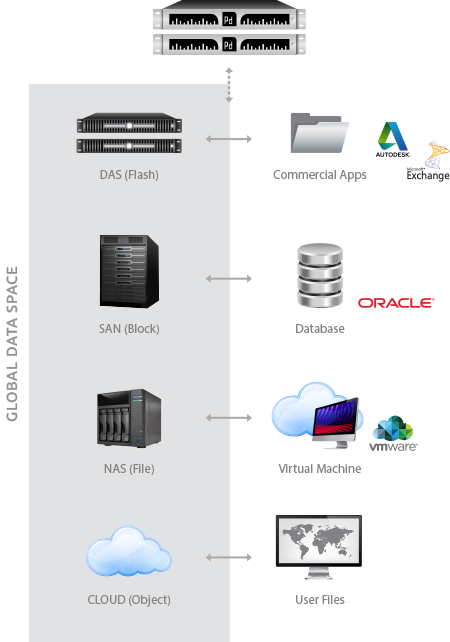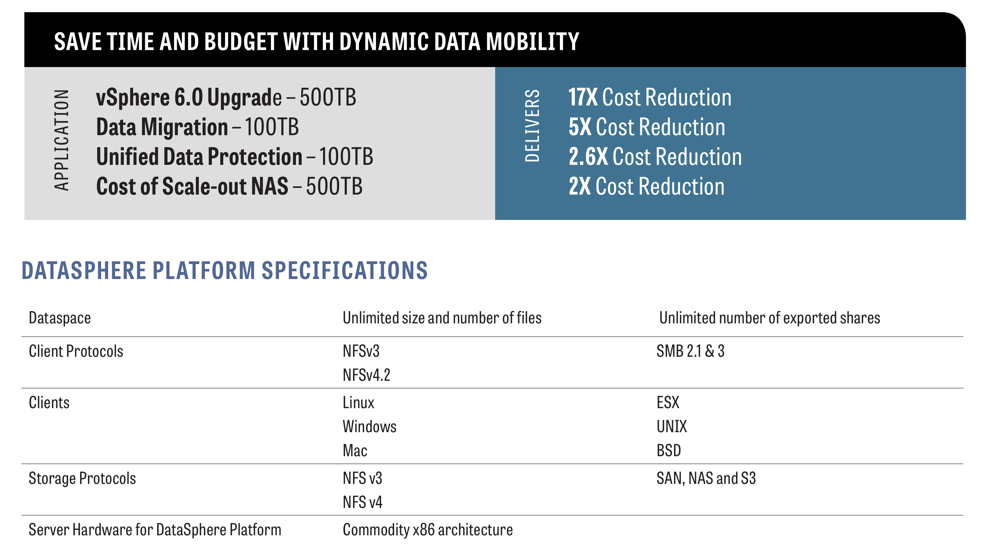Primary Data DataSphere
Enterprise data orchestration software platform to automate IT data management and storage services
This is a Press Release edited by StorageNewsletter.com on September 2, 2016 at 3:32 pmAt the VMworld 2016 U.S. conference, Primary Data, Inc. introduced its DataSphere data orchestration platform to automate IT storage services and ensure applications meet business objectives by uniting enterprises’ different storage resources across flash, object/cloud, SAN, and NAS systems for the first time.
Click to enlarge

Through data virtualization, the DataSphere platform transparently connects storage infrastructure from any vendor, media or protocol under a single, global dataspace, allowing data to move between server, shared and cloud storage without application interruption.
“Storage diversity across flash, cloud, hyper-converged, and traditional systems give enterprises the right storage tool for any job, but until now, data has been trapped in the typical storage silos, forcing IT to overprovision and limit the value of billions of dollars of enterprises storage investments,” said Lance Smith, CEO, Primary Data. “DataSphere automatically orchestrates the right data to the right place at the right time according to IT-defined objectives, without business or application disruption. This industry first can easily cut customers’ storage costs in half by finally aligning data to the ideal storage system according to business needs.“
DataSphere unites heterogeneous storage resources across file, block and object protocols by separating the data path from the control path through data virtualization. The storage-agnostic DataSphere architecture gives customers the flexibility to add new storage resources to their infrastructure. By connecting storage resources across a global dataspace, DataSphere increases utilization of existing storage to reduce overprovisioning and save budget.
DataSphere sets a standard for enterprise agility with storage policies down to file-level granularity. Application admins are now able to select easy-to-use storage policies on a per application basis and continually validate if the storage is delivering according to the defined policy. It automatically aligns application I/O with available storage resources to meet the application owner’s business needs. In addition, Smart Objectives, a feature of DataSphere, enables IT to manage the data lifecycle without any impact to application data availability and performance. Data is load balanced across all available resources in real-time to ensure business requirements are continually met by the infrastructure, minimizing overprovisioning and the cost of maintaining individual storage silos for each application.
DataSphere platform delivers benefits to enterprises, including ability to:
-
Simplify management by converging data using automated orchestration across all storage
-
Reduce costs of overprovisioning up to 50% by increasing storage utilization
-
Respond instantly to new and changing application needs
-
Increase application uptime during migrations and upgrades
-
Gain agility and customer choice by enabling scale out storage with any vendors
In addition to delivering automation and optimization across storage systems, DataSphere enables enterprises to maintain SLAs, automate data lifecycle management, expand scale out storage to more workloads, and add VMware Virtual Volumes for VM-aware storage using existing storage resources.
Click to enlarge

DataSphere utilizes next-generation storage analytics and efficiency through a number of features that automate data orchestration across enterprise storage systems.
These include:
-
Data awareness offers insight into applications’ storage usage and requirements, as well as storage utilization across systems connected to DataSphere
-
Storage awareness provides visibility into storage system capabilities to ensure the appropriate storage type is paired to meet application needs
-
Dynamic data orchestration places data according to data objectives and storage resource availability for optimal data placement
-
Non-disruptive data mobility automatically realigns data placement as business needs change, to ensure service levels are met, without application disruption or any impact to performance
-
Unified storage management simplifies administration of storage capacity across separate systems by delivering a single virtual pool of aggregated storage managed in DataSphere
IT industry analyst firm Gartner has taken note of how data virtualization software can introduce operational efficiencies beyond traditional architectures, and recently reported that new computing styles and approaches will complement server virtualization.
“As an increasingly important part of a comprehensive data integration strategy, data virtualization is attracting renewed interest as organizations recognize its potential for a growing range of use cases (*),” according to Gartner. “Data silos slow organizations’ transformation into digital business by limiting information discovery and access. Data virtualization offers information leaders a mitigation strategy that can lead to new analytical and operational opportunities. Through 2020, 35% of enterprises will implement some form of data virtualization. (**)“
The DataSphere platform is available from the company and its reseller partners.
(*) Gartner, Market Guide for Data Virtualization, Ehtisham Zaidi, Mark A. Beyer, Shubhangi Vashisth, July 25, 2016
(**) Gartner, Use Data Virtualization to Help Resolve Data Silos, Mark A. Beyer, Eric Thoo, Nick Heudecker, May 20, 2016














 Subscribe to our free daily newsletter
Subscribe to our free daily newsletter

